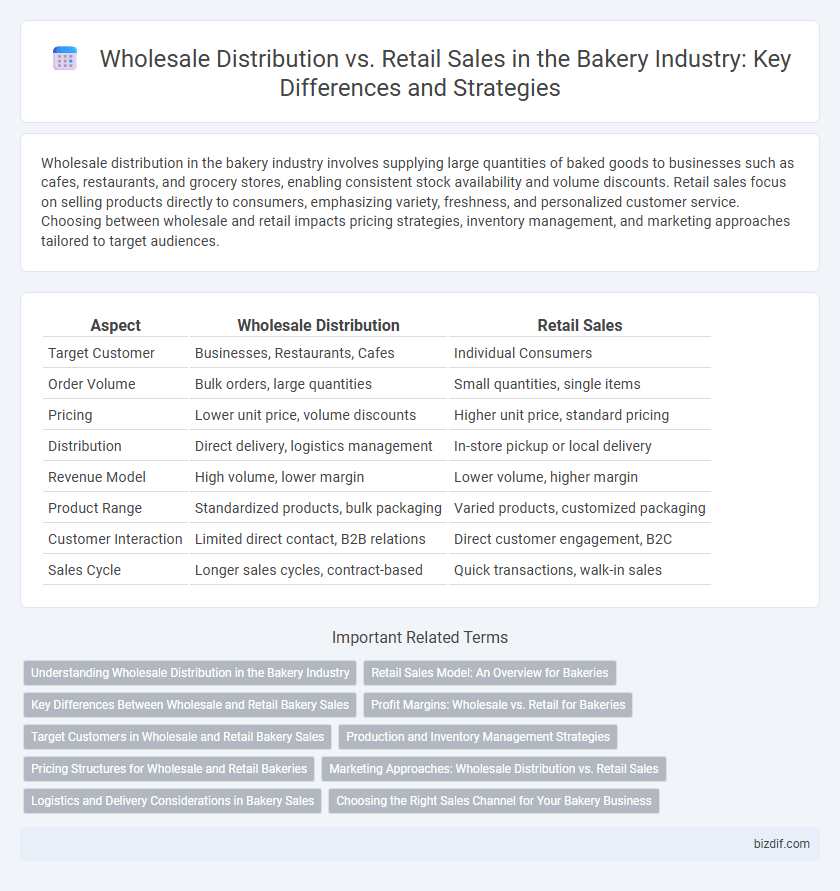Wholesale distribution in the bakery industry involves supplying large quantities of baked goods to businesses such as cafes, restaurants, and grocery stores, enabling consistent stock availability and volume discounts. Retail sales focus on selling products directly to consumers, emphasizing variety, freshness, and personalized customer service. Choosing between wholesale and retail impacts pricing strategies, inventory management, and marketing approaches tailored to target audiences.
Table of Comparison
| Aspect | Wholesale Distribution | Retail Sales |
|---|---|---|
| Target Customer | Businesses, Restaurants, Cafes | Individual Consumers |
| Order Volume | Bulk orders, large quantities | Small quantities, single items |
| Pricing | Lower unit price, volume discounts | Higher unit price, standard pricing |
| Distribution | Direct delivery, logistics management | In-store pickup or local delivery |
| Revenue Model | High volume, lower margin | Lower volume, higher margin |
| Product Range | Standardized products, bulk packaging | Varied products, customized packaging |
| Customer Interaction | Limited direct contact, B2B relations | Direct customer engagement, B2C |
| Sales Cycle | Longer sales cycles, contract-based | Quick transactions, walk-in sales |
Understanding Wholesale Distribution in the Bakery Industry
Wholesale distribution in the bakery industry involves supplying large quantities of baked goods to retailers, restaurants, and institutions, enabling consistent product availability across various locations. This model streamlines supply chains and reduces per-unit costs through bulk production and transportation efficiencies. Understanding wholesale distribution helps bakeries scale operations and expand market reach beyond direct consumer sales.
Retail Sales Model: An Overview for Bakeries
The retail sales model for bakeries emphasizes direct interaction with customers, offering fresh, customized baked goods that cater to local tastes and preferences. This model allows bakeries to maintain control over product presentation, quality, and customer experience, which can increase brand loyalty and repeat business. Retail sales also enable bakeries to react quickly to market trends and seasonal demands, optimizing inventory and reducing waste.
Key Differences Between Wholesale and Retail Bakery Sales
Wholesale bakery sales involve selling large quantities of baked goods to businesses like cafes, restaurants, or grocery stores, often at lower prices per unit. Retail sales focus on direct-to-consumer transactions, offering smaller quantities with a higher profit margin and personalized customer service. Key differences include pricing strategies, order volume, customer base, and packaging requirements.
Profit Margins: Wholesale vs. Retail for Bakeries
Wholesale distribution in bakeries typically offers lower profit margins per unit compared to retail sales, but enables higher volume sales that can stabilize overall revenue. Retail sales allow bakeries to capture greater per-item profits by directly engaging customers, often leading to higher markups on products like specialty breads or pastries. Balancing wholesale and retail channels is essential for maximizing profitability, with wholesale providing consistent cash flow and retail driving premium pricing opportunities.
Target Customers in Wholesale and Retail Bakery Sales
Wholesale distribution in bakery primarily targets bulk buyers such as cafes, restaurants, hotels, and grocery stores seeking large quantities of baked goods at competitive prices. Retail bakery sales focus on individual consumers and walk-in customers looking for freshly baked products with personalized service and immediate purchase options. Understanding these distinct customer bases allows bakeries to tailor product offerings and marketing strategies effectively for wholesale versus retail channels.
Production and Inventory Management Strategies
Wholesale distribution in bakery operations requires bulk production planning and inventory management systems designed to handle large order volumes and minimize storage costs. Retail sales demand more flexible production schedules and just-in-time inventory strategies to cater to diverse consumer preferences and reduce waste. Effective integration of demand forecasting tools and real-time inventory tracking optimizes both wholesale and retail supply chains in bakery businesses.
Pricing Structures for Wholesale and Retail Bakeries
Wholesale distribution pricing in bakeries typically involves bulk discounts and lower per-unit costs to encourage large orders from retailers or foodservice providers, optimizing volume sales. Retail sales pricing is higher per unit due to factors like direct consumer access, smaller purchase quantities, and added expenses such as packaging, marketing, and storefront operations. Understanding these distinct pricing structures enables bakeries to balance profit margins while meeting the demands of both wholesale clients and individual customers.
Marketing Approaches: Wholesale Distribution vs. Retail Sales
Wholesale distribution in the bakery sector leverages bulk marketing strategies, targeting large buyers such as supermarkets, restaurants, and cafes with an emphasis on volume discounts and long-term contracts. Retail sales prioritize consumer-focused marketing approaches like in-store promotions, sensory experiences, and seasonal product launches to drive immediate purchase decisions. Understanding the distinct customer bases and purchasing behaviors allows bakeries to tailor their marketing efforts effectively for each channel, maximizing brand reach and revenue.
Logistics and Delivery Considerations in Bakery Sales
Wholesale distribution in bakery sales requires robust logistics capabilities to handle large volume orders with consistent quality and timely delivery to multiple clients such as supermarkets and restaurants. Retail sales demand more frequent, smaller deliveries focused on freshness, customer preferences, and efficient inventory turnover to maintain product appeal. Optimizing delivery routes, temperature control, and inventory management systems are crucial for both distribution models to minimize spoilage and ensure product availability.
Choosing the Right Sales Channel for Your Bakery Business
Wholesale distribution offers bakeries the advantage of larger volume sales and steady demand from retailers and food service providers, maximizing production capacity and operational efficiency. Retail sales enable direct customer engagement, allowing bakeries to build brand loyalty and test new products with immediate feedback. Selecting the right sales channel depends on factors such as production scale, target market, profit margins, and the ability to manage supply chain logistics effectively.
Wholesale Distribution vs Retail Sales Infographic

 bizdif.com
bizdif.com